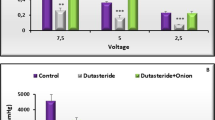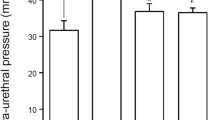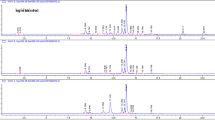Abstract
Background: Benign prostatic hyperplasia (BPH) is the non-malignant, uncontrolled growth of glandular and stromal elements of the prostate gland. Lipid extracts from Saw palmetto (Arecaceae) fruits are widely used to treat BPH. The Cuban royal palm (Roystonea regia) is a member of the same family. Previous studies have found that D-004, a lipid extract from the R. regia fruit, administered orally at 200–800 mg/day for 14 days, prevented testosterone- but not dihydrotestosterone-induced prostate hyperplasia in rats.
Objective: To determine whether D-004 can inhibit noradrenaline (NA) [norepinephrine]- and acetylcholine (ACh)-induced smooth muscle contraction in rat vas deferens and to investigate the in vivo effects of D-004 on NA pressure-elevating effects in rats, an effect mediated by vascular α1-adrenoceptors.
Methods: in vitro effects were investigated by adding D-004 (125–500 μg/mL) to preparations of rat vas deferens suspended in an organ bath containing Tyrode’s solution, in which in vitro contractions were induced by NA or ACh. Negative and positive controls containing Tyrode’s solution alone or with Saw palmetto extracts (125–500 μg/mL), respectively, were included. To assess the in vivo effects of D-004 on arterial blood pressure, rats were randomly distributed to one of five groups (ten rats/group): these consisted of a negative control group receiving the vehicle, two groups treated with D-004 (400 and 800 mg/kg) and two other groups treated with Saw palmetto (400 and 800 mg/kg). All treatments were orally administered. Rats were anaesthetised with sodium thiopental. Heart rate and blood pressure were registered in baseline conditions. Immediately afterwards, rats were injected intravenously over 5 seconds with successive doses of NA (1, 2 and 4 μg/kg) [0.1mL/100g], with 5 minutes’ interval between doses.
Results: D-004 and Saw palmetto (125–500 μg/mL) significantly (p < 0.05) and dose dependently inhibited contractions induced by NA in rat vas deferens versus control. D-004 was more effective in inhibiting NA-induced contractions than Saw palmetto. The contractions induced by NA in preparations with D-004 (500 μg/mL) were weaker (p < 0.05) than in preparations containing Saw palmetto (500 μg/mL). At 125 μg/mL, D-004 inhibited the contractions induced by NA 1 and 32 × 10−6 mol/L by 70.8% and 28.5%, respectively, and Saw palmetto by 56.2% and 10.7%, respectively. At 500 μg/mL, D-004 inhibited these contractions by 100.0% and 71.3%, and Saw palmetto by 80.0% and 42.7%, respectively. The inhibitory concentrations of 50% (IC50) for NA contractions were 148.34 (D-004) and 188.38 (Saw palmetto) μg/mL. D-004 and Saw palmetto significantly (p < 0.05) and to a similar extent inhibited ACh-induced contractions, but less effectively than contractions induced by NA, since at 125 μg/mL they were ineffective. At a dose of 800 mg/kg, but not at 400 mg/kg, D-004 and Saw palmetto inhibited the pressure-elevating effects induced with low (1 μg/kg) but not with high doses (2 and 4 μg/kg) of NA.
Conclusions: D-004 and Saw palmetto extracts inhibited in vitro the contractile responses to NA and ACh in rat vas deferens, and were more effective in inhibiting NA than ACh contractions. The in vivo effects of D-004 and Saw palmetto on the hypertensive response induced by NA were significant but modest. These results are preliminary as the relevance of the effects of D-004 on α1-adrenoceptors deserves further investigation, including comparative studies versus specific defined α1-adrenoceptor antagonists.




Similar content being viewed by others
Notes
The use of trade names is for product identification purposes only and does not imply endorsement.
References
Madsen FA, Bruskewitz RC. Benign prostatic hyperplasia pathophysiology and pharmacological treatment. Curr Opin Nephrol Hypertens 1995; 4: 455–9
Oesterling JE. Benign prostatic hyperplasia: medical and minimal invasive treatment options. N Engl J Med 1995; 332: 99–109
Barry MJ, Roehrborn CG. Clinical review: extracts from clinical evidence: benign prostatic hyperplasia. BMJ 2001; 323: 1042–6
Bhargava S, Canda AE, Chapple CR. A rational approach to benign prostatic hyperplasia evaluation: recent advances. Curr Opin Urol 2004; 14: 1–6
Carson C, Rittmaster R. The role of dihydrotestosterone in benign prostatic hyperplasia. Urology 2003; 61 Suppl. 1: 2–7
Deslypere JP, Young M, Wilson JD, et al. Testosterone and 5 α dihydrotestosterone interact differently with the androgen re-ceptor to enhance transcription of the MMTV-CAT reporter gene. Mol Cell Endocrinol 1992; 88: 15–22
Djavan B, Remzi M, Erne B, et al. The pathophysiology of benign prostatic hyperplasia. Drugs Today (Barc) 2002; 38: 867–76
Lepor H, Tang R, Meretyk S, et al. Binding and functional properties of alpha-1 adrenoceptors in different regions of the human prostate. J Urol 1993; 150: 253–6
Yamada S, Ashizawa N, Ushijima H, et al. Alpha-1 adrenoceptors in human prostate: characterization and alteration in benign prostatic hypertrophy. J Pharmacol Exp Ther 1987; 242: 326–32
Wang JM, McKenna KE, McVary KT, et al. Requirement of innervation for the maintenance of structural and functional integrity in the rat prostate. Biol Reprod 1991; 44: 1171–6
Martínez-Piñeiro L, Dahiya R, Nunes LL, et al. Pelvic plexus denervation in rats causes morphologic and functional changes of the prostate. J Urol 1993; 150: 215–8
Roehrborn CG, Schwinn DA. Alpha 1-adrenergic receptors and their inhibitors in lower urinary tract symptoms and benign prostatic hyperplasia. J Urol 2004; 171: 1029–35
Boyle P, Gould AL, Roehrborn CG. Prostate volume predicts outcome of treatment of benign prostatic hyperplasia with finasteride: meta-analysis of randomized clinical trials. Urology 1996; 48: 398–405
Bartsch G, Rittmaster RS, Klocker H. Dihydrotestosterone and the role of 5 alpha-reductase inhibitors in benign prostatic hyperplasia. Urologe A 2002; 41: 412–24
Sandhu JS, Te AE. The role of 5 alpha-reductase inhibition as monotherapy in view of the MTOPS data. Curr Urol Rep 2004; 5: 274–9
Carruthers SG. Adverse effects of alpha 1 adrenergic blocking drugs. Drug Saf 1994; 11: 12–7
Desgrandchamps F. Who will benefit from combination therapy? The role of 5 alpha reductase inhibitors and alpha blockade: a reflection from MTOPS. Curr Opin Urol 2004; 14: 17–20
Braekman J. The extract of Serenoa repens in the treatment of benign prostatic hyperplasia: a multicenter open study. Curr Ther Res Clin Exp 1994; 55: 776–86
Andro MC, Riffaud JP. Pygeum africanum extract for the treatment of patients with benign prostatic hyperplasia: a review of 25 years of published experience. Curr Ther Res Clin Exp 1995; 56: 1–22
Rhodes L, Primka RL, Berman C, et al. Comparison of finasteride (Proscar), a 5a reductase inhibitor, and various commercial plant extracts on in vitro and in vivo 5 α- reductase inhibition. Prostate 1993; 22: 43–51
Bombardelli E, Morazzoni P. Serenoa repens (Bartram) JK Small. Fitoterapia 1997; 68: 99–113
Plosker GL, Brogden RN. Serenoa repens (Permixon): a review of its pharmacological and therapeutic efficacy in benign pro-static hyperplasia. Drugs Aging 1996; 9: 379–95
Wilt TJ, Ishani A, Stark G, et al. Saw palmetto extracts for treatment of benign prostatic hyperplasia: a systematic review. JAMA 1998; 280: 1604–9
Gordon AE, Shaughnessy AF. Saw palmetto for prostate disorders. Am Fam Physician 2003; 67: 1281–3
Goepel M, Hecker U, Krege S, et al. Saw palmetto extracts potently and non-competitively inhibit human alpha 1 adre-noceptors in vitro. Prostate 1999; 38: 208–15
Marks E. Effects of Saw palmetto herbal blend in men with symptomatic benign prostatic hyperplasia. J Urol 2000; 163: 1451–6
Carraro JC, Raynaud JP, Koch G, et al. Comparison of phytotherapy (Permixon) with finasteride in the treatment of benign prostate hyperplasia: a randomized international study of 1098 patients. Prostate 1996; 29: 231–40
Carbin BE, Larsson B, Lindahl O. Treatment of benign prostatic hyperplasia with phytosterols. Br J Urol 1990; 66: 639–41
Gutierrez M, Garcia de Boto MJ, Cantabrana B, et al. Mechanisms involved in the spasmolytic effect of extracts from Sabal serrulata fruit on smooth muscle. Gen Pharmacol 1996; 27: 171–6
Odenthal KP, Rauwald HW. Lipophilic extract from Sabal serrulata inhibits contractions in smooth muscle tissue. Ak-tuelle Urol 1996; 27: 152–7
Arruzazabala ML, Carbajal D, Mas R, et al. Preventive effects of D-004, a lipid extract from Cuban royal palm (Roystonea regia) fruits, on prostate hyperplasia induced with testosterone on intact and castrated rodents. Drugs Exp Clin Res 2004; XXX: 227–33
Carbajal D, Arruzazabala ML, Mas R, et al. Effect of D-004, a lipid extract from Cuban Royal Palm fruit, on inhibiting pro-static hypertrophy induced with testosterone or dihydrotestos-terone in a rat model: a randomized controlled study. Curr Ther Res Clin Exp 2004; 65: 505–14 2004, 65
Michel M, Taguchi K, Schafers RF, et al. α 1-Adrenoceptor subtypes in the human cardiovascular and urogenital systems. Adv Pharmacol 1998; 42: 394–8
Schafers RF, Poller U, Ponicke K, et al. Adrenergic and muscarinergic blockade and the cardiovascular effects of exoge-nously administered and endogenously released noradrenaline in humans. Naunyn Schmiedebergs Arch Pharmacol 1996; 335: 239–49
Michel MC, Grubbel B, Taguchi K, et al. Drugs for treatment of benign prostatic hyperplasia: affinity comparison at cloned α1-adrenoceptor subtypes and in human prostate. J Auton Pharmacol 1996; 16: 21–8
Hieble JP, Ruffolo Jr RR. The use of alpha-adrenoreceptor antagonists in the pharmacological management of benign prostatic hypertrophy: an overview. Pharmacol Res 1996; 33: 145–60
Kirby RS, Roehrborn CG, Boyle P, et al. Efficacy and tolerability of doxazosin and finasteride, alone and in combination, in treatment of benign prostatic hyperplasia: the Prospective Eu-ropean Doxazosin and Combination Therapy (PREDICT) trial. Urology 2003; 61: 267–8
McConnell JD, Roehrborn CG, Bautista OM, et al. The longterm effect of doxazosin, finasteride, and combination therapy on the clinical progression of benign prostatic hyperplasia. N Engl J Med 2003; 349: 2387–98
Doggrell SA. Combination of finasteride and doxazosin for the treatment of benign prostatic hyperplasia. Expert Opin Pharmacother 2004; 5: 1209–11
Acknowledgements
This study was supported by a research grant from the West Havana Scientific Pole. The people involved in the conduct of this study did not receive any special financial or other rewards for their participation in the study, and the authors have no conflicts of interest other than that they have participated in this research project.
Author information
Authors and Affiliations
Corresponding author
Rights and permissions
About this article
Cite this article
Arruzazabala, M.L., Más, R., Carbajal, D. et al. Effect of D-004, a Lipid Extract from the Cuban Royal Palm Fruit, on in vitro and in vivo Effects Mediated by α-Adrenoceptors in Rats. Drugs R D 6, 281–289 (2005). https://doi.org/10.2165/00126839-200506050-00004
Published:
Issue Date:
DOI: https://doi.org/10.2165/00126839-200506050-00004




